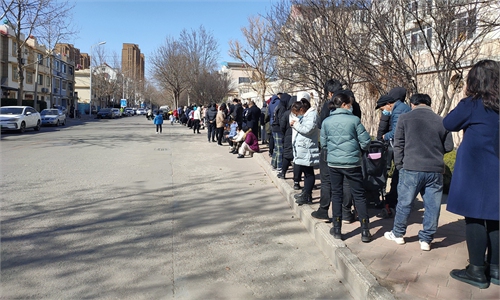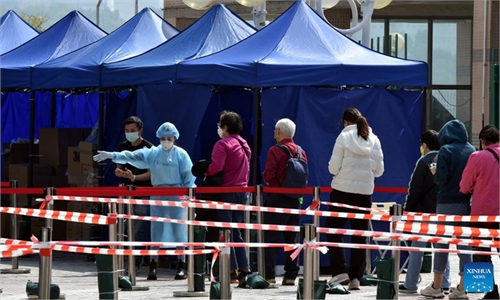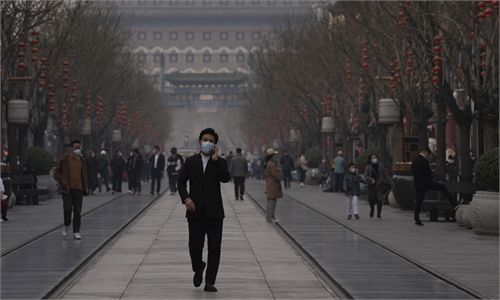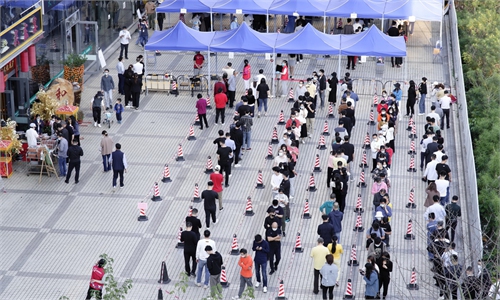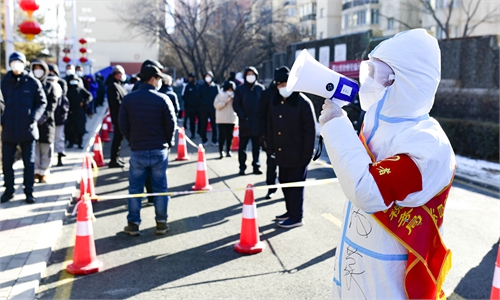Metropolises take strictest measures in 2 years as China reports more than 10,000 cases since March
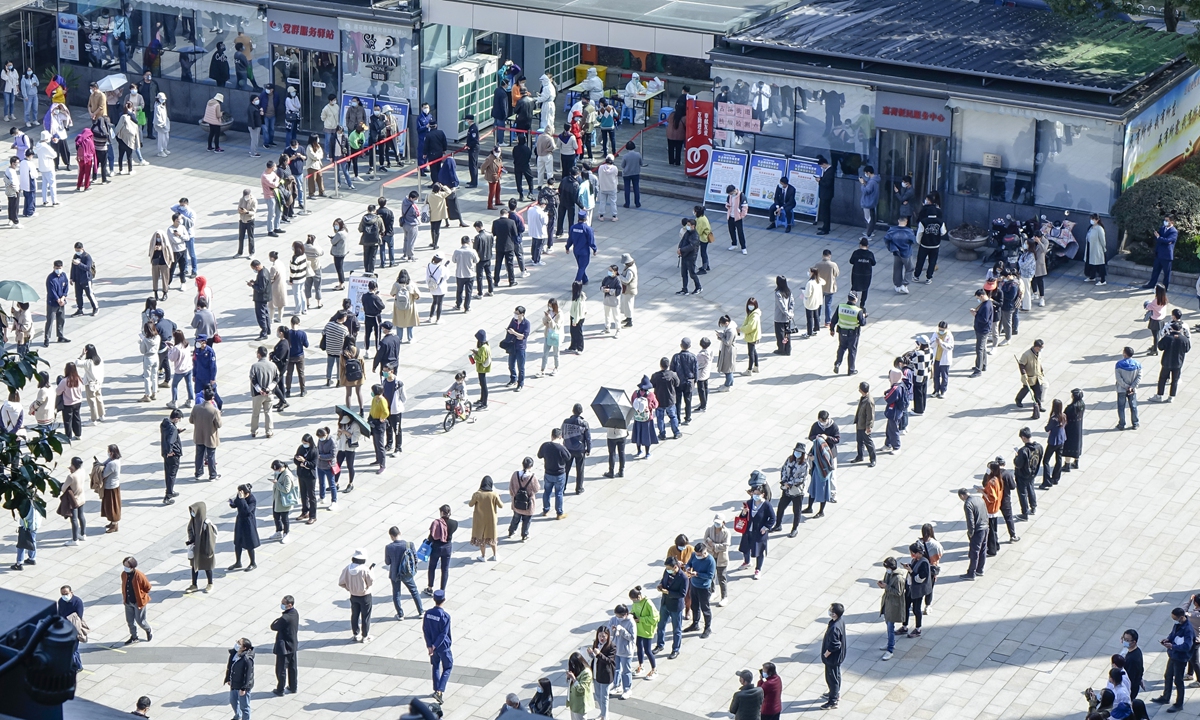
Residents line up for COVID-19 nucleic acid tests in Hangzhou, East China's Zhejiang Province on March 11, 2022. China is facing extensive domestic flare-ups, registering 1,100 infections, including silent carriers the day after counting more than 500 cases for three consecutive days. Photo: IC
China is battling its worst outbreaks in two years with the number of cases surging to more than 10,000 since March 1 in 27 provinces and municipalities. Many places, including Shenzhen and Shanghai, where the virus is rife, responded with the strictest measures in reducing social contacts to curb the viral infections in short notice.
Epidemiologists believe the explosion of cases outside China, as many countries dropped their COVID-19 policies, make it difficult to detect the more concealed yet highly contagious cases, and local officials' loosening on COVID-19 controls are behind this sudden surge of China. Yet they noted that when weathering outbreaks, the zero-COVID policy, currently the best strategy for China, is slowly undergoing changes, and will continue changing, citing allowing the use of COVID-19 antigen self-testing kits as a sign of a possible adjustment.
They also opined that adjustments do not mean dropping the COVID-19 policy completely. China, being a country that prioritizes people's lives, will only relax the current policy when strong immunity are built, effective medicine comes into light, hospitals have well prepared for case surges, and society drops its fear of the virus and reach a consensus on opening again.
Since the beginning of March, a total of 27 provincial-level localities reported COVID-19 cases, and the number of cases has climbed to over 10,000 from March 1 to 13 (Sunday), the National Health Commission (NHC) said on Monday. It said that the situation in Jilin, Guangdong and Shanghai have yet to peak. The NHC noted that China's overall zero-COVID policy is still effective in battling the Omicron variant, but faster, quicker, stricter measures are needed to cope with the highly contagious variant.
The country reported 1,337 cases and 788 silent carriers on Monday.
As Northeast China's Jilin Province recorded 895 cases on Monday, people in the province - especially those in the cities of Changchun and Jilin, two cities most ravaged by coronavirus - are forbidden from leaving their home cities, prefectures and out of the province.
Shenzhen, a metropolis of roughly 13 million, slapped stringent measures to curb virus transmissions on Sunday night.
Another metropolis that is responding against a COVID-19 outbreak with strict measures is China's poster child in dealing with the virus— Shanghai. The city reported a sharp increase in cases on Monday, with 41 confirmed cases and 128 silent carriers. Shanghai on Saturday barred residents from leaving the city unless necessary and must have a negative nucleic test as well.
Several schools in Beijing have ordered some students at high risk of infection to stay at home. The measures showed mounting pressure the capital faces to contain the coronavirus.
According to a simulation model Huang Jianping from Lanzhou University and his team developed, under strict and timely control measures, this wave of outbreaks will be initially controlled by early April, with 35,000 infected.
The sudden surge in cases is partly because the highly contagious Omicron variant and its strains (which are detected in many places in China) make it very hard to detect, and their incubation period is much shorter than other known variants of coronavirus, a senior expert close to the Chinese Center for Disease Control and Prevention (CDC) told the Global Times on condition of anonymity on Monday.
He said that as the pandemic has dragged on for two years, some local officials have relaxed their COVID-19 prevention efforts, which has led to a slow response to outbreaks and late imposition of virus prevention measures, and delayed quarantine of confirmed patients and silent carriers.
Lu Hongzhou,head of Shenzhen's anti-epidemic expert team and head of the Third People's Hospital of Shenzhen, stressed that local governments must maintain routine nucleic tests or COVID-19 antigen testing kits for people at high risk, including those who works in ports and the logistics industries.
The fact that many countries are dropping or have already dropped their COVID-19 measures and are ready to "coexist with the virus" also poses a great challenge for China to fend off the virus, especially in border cities, said the CDC expert.
Possible adjustments
On his Sina Weibo account, Zhang Wenhong, an infectious disease expert in Shanghai, described it as the "most difficult period in two years' COVID-19 battle." He admitted that the virus is not as powerful as it was before, and there are very few severe cases, and no deaths have been reported in the Chinese mainland for a long time.
Yet, those are not the excuses for us to "lie flat," said Zhang, noting we should have clear plan, instead of arguing continuing zero-COVID policy or "coexisting with the virus."
Chen Xi, an associate professor at the School of Public Health of Yale University, told the Global Times on Monday that he believes China's dynamic zero-COVID policy has already adjusted during previous waves of outbreaks. Under the attacks of the Delta variant, the government allowed local authorities some time to clear cases, which was different from the absolute zero case policies in early 2020, according to Chen.
Chen said that in the face of Omicron, epidemic control should allow certain flexibility while generally sticking to the dynamic zero-COVID goal to pare back the impact on the economy.
Some experts pointed out the COVID-19 antigen testing kits may also serve as a sign of policy adjustments.
Jin Dongyan, a biomedical professor at the University of Hong Kong, said China is adjusting its dynamic COVID-19 strategy according to the characteristics of the variants, and the fast spread of Omicron may bring more changes in China's response measures.
With the nationwide promotion of self-testing kits, it's likely that many people with mild symptoms or no symptoms and people who are close contacts of them could be quarantined at home instead of in designated hotels, which could also prevent cross infections and save resources, Jin said.
And those who have children or elderly people at home could still get quarantined at designated places or hospitals, Jin said.
Amid the fast spread of Omicron, China may also adjust its mixed nucleic acid testing policy, in which five or ten samples were mixed in one group for speed testing, as the surge in cases indicate a large number of mixed tests will turn positive and require many people to be retested, Jin said.
Yet, epidemiologists said that any adjustment in prevention policy should not be interpreted as China dropping its zero-COVID strategy.
As Zhang Wenhong pointed out, swiftly lifting COVID-19 prevention measures could lead to a surge in infections, and overwhelm the medical system, and paralyze social activities no matter how low the mortality rate is. Many elderly people and people with underlying diseases in China are not vaccinated. The consequences would be "unthinkable" if those groups of people get the virus, said Zhang.
Yu Wenzhou, a medical expert at Chinese CDC, revealed in a March conference that less than 40 percent of people aged over 60 had got a booster shot, and in some provinces, less than 30 percent did so.
The above-quoted CDC expert told the Global Times that the premises for China to relax policies are to build a stronger immunity , which means higher vaccine coverage. Lu Hongzhou from Shenzhen also stressed the importance of vaccines, especially inhaled vaccines, which he believes provide better protection for the respiratory system.
The third-generation vaccine, represented by the aerosolized AD5-Ncov vaccine developed by CanSinoBIO, had proven to be a better choice for heterologous vaccination boosters, the latest research data showed.
The results show that the Ad5-nCoV booster induced potent neutralizing activity against the wild-type virus and Omicron variant, while aerosolized (inhaled) Ad5-nCoV generated the greatest neutralizing antibody responses, several times higher than traditional inactivated shots, against the Omicron variant at day 28 after booster vaccination.
Other factors include whether there is effective treatment for the disease, the CDC expert said, noting medical institutes should be prepared, including expanding their capacity, outlining plans for a possible surge, and establishing categorized systems for different patients.
Another premise is for the society to reach a consensus on relaxing policies, and avoiding panic. The government will do its best to walk out of the pandemic with the lowest mortality rate, said the anonymous expert with CDC.
"For the coronavirus, quelling fear is the first step we must undertake," said Zhang.
